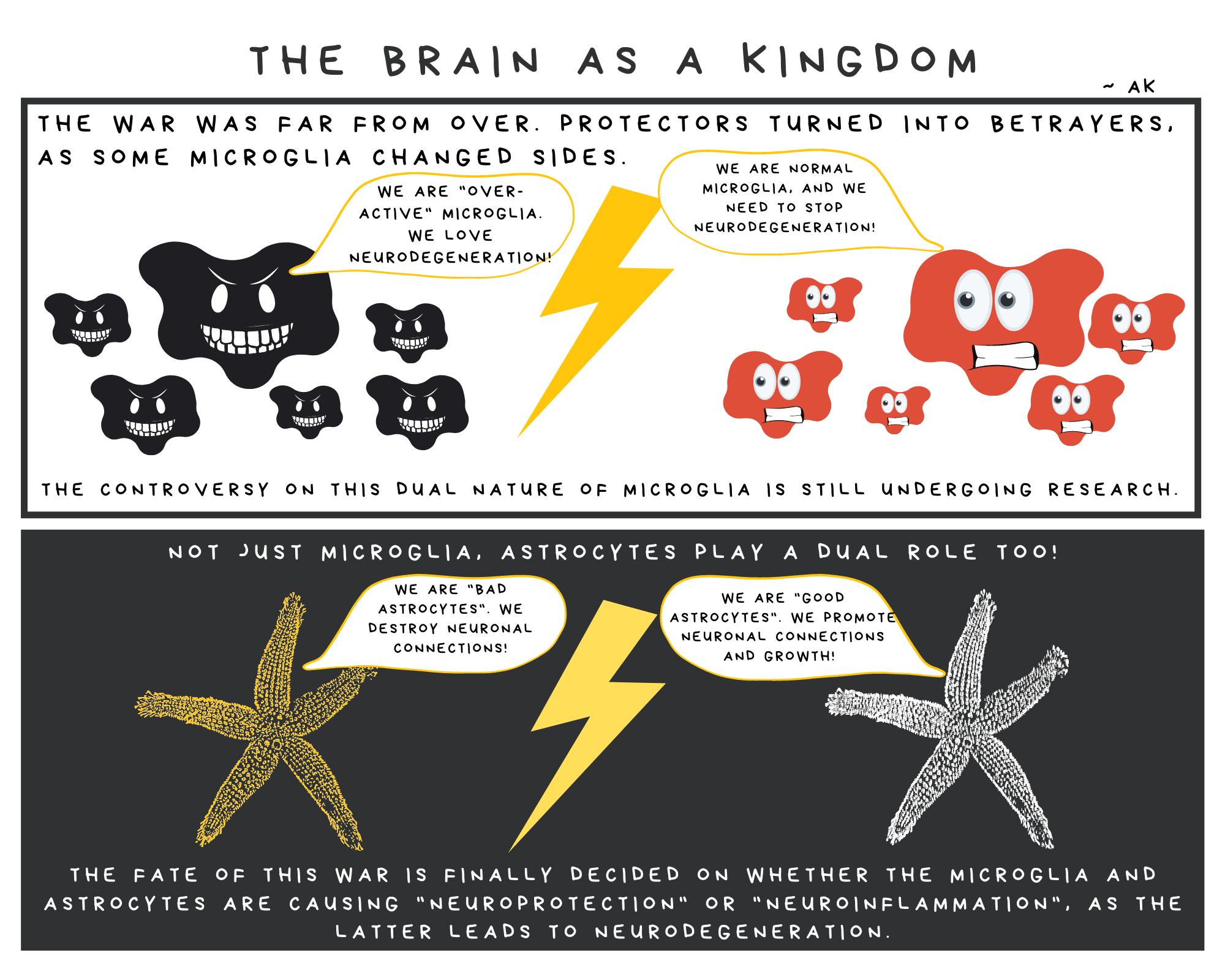Have you ever considered the brain as a kingdom? The rulers of the kingdom are the brain cells, viz., neurons. But the brain is not occupied by neurons only; half of it is occupied by housekeeping and army cells called glia. There are two major brain warriors – microglia and astrocytes. They are always busy ensuring a heavenly stay for neuronal cells. They do everything for that. But it’s not easy to be in their shoes.
“Divide and attack” Captain Microglia gave the command to surrounding glia and astrocytes. They started growing and producing new chemical weapons to prevent further collapse. They are fighting an internal threat. The old microglia yelled, “Inflammation!” as it gulped another dead neuron. “We need to protect them before more of them die and affect the entire body.”

Little astrocytes remembered from the training that inflammation is the body’s response to any threats like injuries or pathogens. If it was some other body part and not the brain, by this time there would have been swelling, pain, redness, heat, and sometimes even loss of function. But all these symptoms are means of signalling to these warriors in the body. There are different kinds of them patrolling through blood. Once they get the signal, they all get ready for the fight and run to the site. There are other glia-like cells called macrophages. They come and clear the problems by engulfing pathogens and dead cells. In addition to this, they produce factors (Neurotrophic factors) that promote neuronal growth and survival.
But the brain is more sophisticated than other body parts. It has a specialized surveillance system called the blood-brain barrier. It stops almost everything coming towards the brain. Only oxygen and broken food molecules can enter the brain. But some attackers are very clever and they somehow manage to fool all these barrier cells and get through them.
But the ongoing threat does not seem like an external attack. The cells heard the code word again— “neurodegeneration.” Oh, so this is not a simple threat or something that occurs often. They can only keep the battle – the kingdom brain is going to collapse soon.

Astrocyte repeated the textbook lines: Neurodegeneration is a progressive decrease or loss in the function of neurons and leads to diseases. Proteins called beta-amyloid club together and form rope-like structures leading to Alzheimer’s disease (AD). These structures interfere with the cells’ normal functioning. In Parkinson’s disease (PD), alpha-synuclein proteins make aggregates and lead to the death of neurons that secretes chemical messengers called dopamine. But not always do the protein aggregates cause neurodegeneration. In Huntington’s disease (HD), the villain is the change in the sequence of the gene Huntington’s. But irrespective of the cause, inflammation is a feature of all neurodegenerative diseases. That is why poor astrocytes understood, they could only fight, and it is going to be the end of the kingdom.
But is that the only concern? Poor astrocyte shivered, “Not really!” Some of the microglia change their side. When they get activated beyond a limit, instead of protecting, they increase the rate of neurodegeneration. Earlier it was thought that microglia are saviours The controversy of microglia as a protector or betrayer is still going on. Studies from Alzheimer’s disease models suggest a delicate balance between these two processes.

How do microglia speed up the process of neurodegeneration? Astrocyte scratched its head. Microglia produce chemicals like reactive oxygen species (ROS: superoxides, nitric oxides (NO), and tumor necrosis factor-alpha (TNF-alpha)). Humans are making everything containing anti-oxidants these days to fight these chemicals from paste to food items.
These molecules damage contents inside the cell. They can also cause alterations in the genetic content and thereby cause deleterious effects. These molecules also lead to the dysfunction of mitochondria, which is the powerhouse of the cell. In short, ROS molecules mess up whole-cell structure and function which cause either fellow cells to take their lives themselves (apoptosis) or by glial cells to kill them (necrosis).
Do you think only the microglia have this opposing role depending on their surroundings? Sadly, astrocytes also change their sides. There are two kinds of astrocytes – good ones and bad ones. We can recognize them by their behaviour (phenotype). But it’s unpredictable who joins the army and who goes against it. Bad astrocytes express chemicals that are involved in destroying connections between neurons. Good astrocytes are mainly found at the site of the damaged brain areas and promote new neuronal connections and neuronal growth. However, it is unclear whether it is a loss of normal function or a gain of toxic function. In the case of Alexander’s disease and hepatic encephalopathy, astrocyte dysfunction leads to the disease condition. Protein aggregation inside astrocytes causes abnormal myelination and neurodegeneration, which are characteristics of these diseases. Whereas in Alzheimer’s’, Parkinson’s’ and Huntington’s diseases and amyotrophic lateral sclerosis (AML), astrocytes induce cytotoxic factors.
Microglia and astrocytes, even though they are of two different clans, are strongly connected. They decide each other’s fate. When the war begins, experienced microglia start signalling to keep exchanging secret chemical messages to ensure the Kingdom Brain is safe. Both are involved in neuroprotection as well as in neuroinflammation (hence neurodegeneration). Therefore, they are good candidates for targeting medicines. Understanding what is causing our clans to turn pro-inflammatory will help to improve the therapeutics. They’re also candidates for targeting glial cells to improve after-effects of neurodegeneration. Meanwhile, little astrocyte grew and set off to help the brain army.
. . .
Writer

Thasneem Musthafa
She is an alumna of the Indian Institute of Science Education and Research (IISER), Pune. She is a biology major interested in exploring neuroscience, behaviour, and epigenetics. She strongly endorses mental health advocacy, equality, and accessibility.
Illustrator

Anushree Krishnamurthy
Co-founder and Director of Website Development and Logistics

